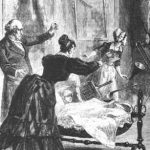Within one year of its organization, the SPR had collected over 400 reports of such cases and in 1886, Gurney published a 1,300 page document entitled Phantasms of the Living in which 702 different apparition cases were analyzed. All of the evidence was obtained firsthand from the percipients and was generally backed by corroboratory testimony. Witnesses were also interviewed by SPR members who appraised the value of all testimony.
Gurney described several categories of apparition cases. These are cases of spontaneous telepathy, which occur when the sender is undergoing some shock or strong emotion. For example a lady lying in bed may feel a pain in her mouth at the exact moment when her husband is accidently struck in the jaw. Then come cases where the percipient’s experience is not an exact reproduction of the agent’s experience, but is only founded upon it, the receiver building a detailed picture from his or her own mind. There are many cases of this type where a person about to arrive at a location is actually seen there by someone not expecting him before his arrival. It is very unlikely that the agent will have in his mind the image of himself as others see him. Finally Gurney refers to the cases in which the agent may be dead or dying while the phantom appears in quite normal behavior and clothing.
Gurney felt that these cases could be explained as hallucinations induced in the mind of the percipient by means of a telepathic message from the agent. What was harder to explain were collective apparitions in which several people independently perceive the identical phantom. There were also reciprocal cases whereby a person imagining himself to be at a distant scene is actually seen at that location by others.
Phantasms of the Living was soon criticized by the eminent American philosopher C. S. Pierce and several others on the grounds that the cases reported did not meet sufficient conditions to be acceptable as evidence. Most of these critical individuals simply did not read the entire book. Their criticisms focused on the weakest cases and overlooked certain cases that were very well documented in all regards. However, Gurney felt that if only a few single cases were strongly evidential, the conclusions for crisis telepathy were inescapable.








